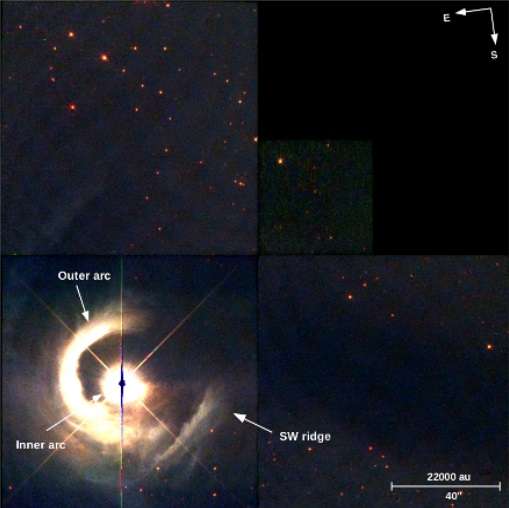April 27, 2016 report
Young star V1331 Cygni unveils its violent past

(Phys.org)—V1331 Cygni is a young variable star that lies in the constellation Cygnus, approximately 1,800 light years away from our planet. The star is known to have a circumstellar disk surrounded by a flattened gaseous envelope that could reveal crucial information on V1331 Cygni's violent past. A recent study of the motion of these circumstellar structures shows that this star must have undergone an outburst a few thousand years ago. The results appeared in a paper published online on Apr. 15 in the arXiv journal.
V1331 Cygni has recently drawn attention of a team of researchers led by Arpita Choudhary of the Institute of Mathematical Sciences in Chennai, India. Intrigued by the presence of ring-shaped features around this young star, the scientists decided to investigate the images of V1331 Cygni obtained by the Hubble Space Telescope (HST), which could reveal possible changes in motion of these circumstellar rings. They compared the HST images taken in 2009 to archival data delivered by this telescope in order to determine the time evolution and to perform a proper motion analysis of the features.
However, as the researchers emphasized, peeking into the real nature of V1331 Cygni and its surroundings wasn't an easy task.
"The resolution obtained from Hubble played a key role to get a better insight in to the dust arc structures. However, the long exposures also caused the star to saturate, making it difficult to study the inner arc especially, because it was too close to the star and the background noise from starlight affected the inner arc profiles very badly," Choudhary told Phys.org.
The team noted that studying the complicated 3D circumstellar structures of V1331 Cygni in a 2-D plane was really challenging. This is because they did not have the access to the third dimensional information and thus had to consider only a planar case.
By investigating two different epochs of Hubble observations, separated by a time of about 10 years, the scientists were able to calculate the expansion of outer and inner dust arc structures around the star. Their analysis provided an explanation of the missing arc part, which was earlier believed to be caused by a dark cloud in the foreground, in front of the arc. According to the research, that dark cloud does not play a role in the missing arc and the gap between the outer arc and the star is real, devoid of any dense matter sitting in between.
In general, the scientists confirmed that V1331 Cygni is a post-outburst FUOR object (named after star FU Orionis)—a pre-main-sequence star that displays an extreme change in magnitude and spectral type. They determined that this star experienced an outburst a few thousand years ago.
"We found measurable expansion velocities for both outer and inner dust arcs. Our results, plus the expanding carbon monoxide torus results, suggest that the star had undergone an outburst in the past," Choudhary concluded.
The circumstellar structures around V1331 Cygni could be compared to expanding smoke rings. The smoke rings expand as they grow away from a point of origin.
Choudhary and her colleagues plan further observations of this curious young stellar object. Their aim is to conduct polarimetric imaging of this star for which an observing proposal will be submitted to Calar Alto 2 meter telescope, located in Spain.
More information: Hubble imaging of V1331 Cygni: Proper motion study of its circumstellar structures, arXiv:1604.03667 [astro-ph.SR] arxiv.org/abs/1604.03667
Abstract
The young star V1331 Cyg received previous attention because it is surrounded by an optical, arc-like reflection nebula. V1331 Cyg is commonly considered to be a candidate for an object that has undergone an FU-Ori (FUOR) the outbreak in the past. This in turn could lead to a time-varying appearance of the dusty arcs that may be revealed by multi-epoch imaging. In particular, a radial colour analysis of the dust arcs can then be attempted to check whether radial grain size distribution was modified by a previous FUOR wind. Second-epoch imaging of V1331 Cyg was obtained by us in 2009 using the Hubble Space Telescope (HST). By comparing this to archival HST data from 2000, we studied the time evolution of the circumstellar nebulae. After a point spread function subtraction using model point spread functions, we used customised routines to perform a proper motion analysis. The nebula expansion was first derived by deconvolving and correlating the two-epoch radial brightness profiles. Additional data from other facilities TLS, UKIDSS, SPITZER, and HERSCHEL were also incorporated to improve our understanding of the star in terms of environment, viewing angle, bipolar outflow length, and the FUOR phenomenon. The derived radial colour profiles do not indicate a spatial separation of the dust grain sizes. The HERSCHEL 160 micron images show for the time thermal emission from dust probably residing in the outer arc. By viewing V1331 Cyg almost pole-on, the length of the bipolar outflow exceeds previous estimates by far. The outer arc expansion timescale is consistent with the implantation time of the CO torus, which supports the hypothesis of an outburst that occurred a few thousand years ago. The azimuthal colour variation of the outer arc is probably due to changes of the scattering angle, imposed by a tilt or helical geometry of the dust configuration.
Journal information: arXiv
© 2016 Phys.org





















